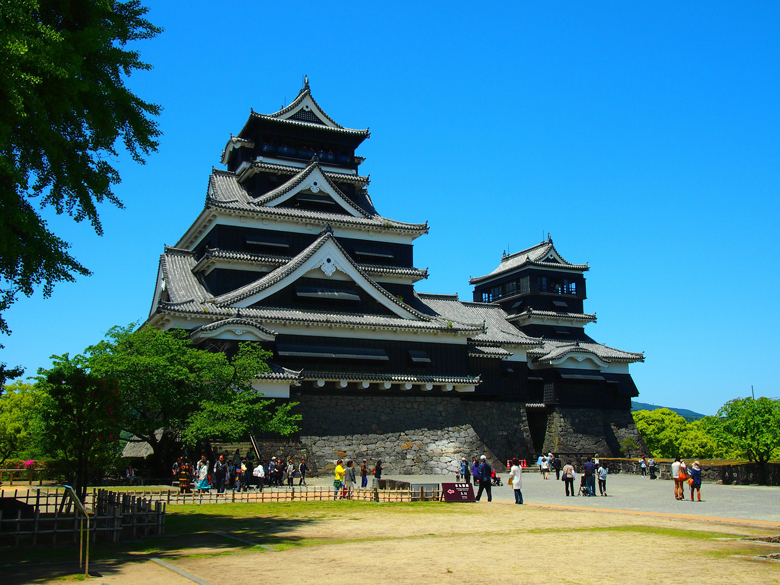Kumamoto City Is the capital of the homonymous prefecture on the island of Kyushu, Japan.
Kumamoto means “origin of the bear”, and its nickname is hi no kuni (land of fire), because of the giant volcano (Mount Aso) and Mori no Miyako (capital of the forest) nearby
The city has five districts: Kita (north), Higashi (east), Minami (south), Nishi (west) and Chuo (center).
This city is the location of Higo Government and Higo Kokubunji. The current urban area is developed based on the 540,000 Ishigashi Castle Town of the Kumamoto clan of the Hosokawa clan. Before the war, the 6th Army Division was stationed with state agencies, and it was a well-represented military capital and administrative city in Kyushu. On March 12, 2011 , the Kyushu Shinkansen Kagoshima Line opened to traffic, and Kumamoto Station became a stop for the Shinkansen.
Forest City
The city is called “the capital of the forest” has been included in the lyrics of Kumamoto city song formulated in 1930 . During the period of high economic growth, Kumamoto’s high-speed urbanization caused a significant reduction in green areas. Therefore, on October 2, 1972 , the Kumamoto City Council passed the “City of Mori” Urban Declaration Resolution, and the “City of Mori” became The official official name is . The urban plan is towards community construction that coexists with nature, trying to create an urban landscape with the theme of “Kumamoto, the beautiful and vibrant forest city”
Access : Coordinates: 32.803056, 130.707778 / Located on the southernmost island of Japan, Kyushu, on the Shirakawa River. The distance to Nagasaki is 70 km by air.
/ Kumamoto Ferries: operates ferries between Shimabara City and Amakusa City. / Kyushu Expressway: Ueki Interchange-Kita Kumamoto Service Area-(Kishi City)-Kumamoto Interchange-Toma Rest Area-(Msushi Town-Mifune Town)-Midorikawa Rest Area
/ flights from nearby Kumamoto Airport can travel to and from Japanese cities outside of Kyushu. /
Highlights :
- Kumamoto Castle : Kumamoto Castle, which was partially reconstructed in the 1960s. Some of the outbuildings of the castle, which was built in 1607 and destroyed by fire during the Satsuma rebellion in 1877, were still in their original state until the Kumamoto earthquake in 2016. However, large parts of the castle were damaged or even destroyed by the earthquake./ Hosokawa Gyobutei : the family home of the Hosokawa Clan ,north-ouest of the castle site.
- The former residence of Hosokawa Gyobo, a younger brother of Hosokawa Tadatoshi, who was the daimyo of the Kumamoto feud from 1633 to 1641, is a well-preserved samurai house that was moved to its current location near the castle in 1993.
- Suizenji Park : a landscape garden that was laid out by Hosokawa Tadatoshi beginning in 1636. Around the pond in the center of the park, stations of the historic Tokaido have been reproduced in miniature, including Mount Fuji.
- Kumamoto Prefectural Museum of Art / Kumamoto Municipal Museum / Contemporary Art Museum, Kumamoto / Shiki no Sato Park. natural hot springs and animal park / Kumamoto Prefectural Traditional Crafts Center /
- Lake Ezu : Lake Ezu is actually made up of two smaller lakes, Kami-Ezu and Shimo-Ezu , The two lakes combine to form a lake with a length of 2.5 kilometers, a circumference of 6 kilometers, and a total lake area of ??about 50 hectares. The springs that supplement the lake water pump out 40,000 tons of fresh fresh water every day on average.
- Honmyo-ji Temple : Is a Buddhist temple of the sect of Nichiren Rokujomon-ryu , located in Nishi-ku City, Kumamoto Prefecture, Japan. It is the highest ranking cult temple in Kyushu. The Honmyo-ji houses the tomb of Kato Kiyomasa, (1562–1611), a founding daimyo of Kumamoto Castle and a follower of Nichiren Buddhism.
- Reigando : ( “Spirit rock cave” ) is a cave on the grounds of the Buddhist temple Unganzen-ji in Kumamoto, Japan. It is known for the fact that the samurai Miyamoto Musashi, as the creator of the “two swords style” Niten Ichiryu, spent the last weeks there before his death. In that cave he wrote the Gorin no Sho ( The Book of the Five Rings), which he passed on to his student Terao Magonojo on May 12, 1645. On June 13, 1645 Miyamoto Musashi died in the Reigando cave
- Kumamoto City Hall : Kumamoto City Hall is a facility (government office) that conducts office work as an executive agency of Kumamoto City, which is a local public organization.
- Mt. Kinpo : A mountain in Japan located on the border between the prefectures of Nagano and Yamanashi. This sacred land of Buddhism and Shintoism belongs to Chichibu Tamakai National Park in the Okuchichibu Mountains, and is listed as one of Japan’s 100 Famous Mountains.
- Fujisaki Hachimangu Shrine : Fujisaki Hachiman-gu Is a Shinto shrine located in Chuo-ku Ward, Kumamoto Prefecture, Japan. It is dedicated to Emperor Ojin, Empress Jingu and the three kamis Sumiyoshi.
- Hanaokayama : Hanaokayama is a mountain located in Nishi-ku, Kumamoto City, Kumamoto Prefecture, at an altitude of 132.2 meters. You can see the city of Kumamoto from the summit.
Activities : sightseeing / photo opportunities / Long distance walking / Scenic Driving- Auto Touring / Ancient Culture Study.
Go next : Amakusa : a city and chain of islands off the west coast of Kumamoto in Japan. / Hitoyoshi : in Kumamoto prefecture, famous for hot springs

